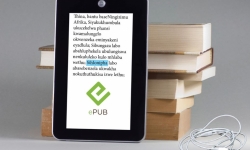Assistive technology for visually impaired, dyslexic and developing readers
The CSIR has developed software to help the publishing industry serve a market that was often overlooked in the past.
The CSIR has developed software to help the publishing industry serve a market that was often overlooked in the past.
This market faces barriers to reading due to visual impairment, dyslexia, low literacy and other special educational needs. The software breaks down these barriers by adding audio to publications and synchronising it with the text. It not only unlocks a new way of reading through listening, but also provides further assistance through audio navigation and visual highlighting of the synchronised text and audio. The product is called iSinkwe, which is the isiZulu name for a bush baby, an animal known for its big eyes and ears. This symbolises how the software empowers the eyes and ears of aspiring readers.
Isinkwe is packaged as three subproducts that revolve around the EPUB 3 publishing standard: the converter, augmenter and reader. The converter converts ebooks in other file formats, such as DOCX and PDF, to EPUB 3. The augmenter uses the CSIR’s Qfrency text-to-speech technology to synchronise the text and audio of EPUB 3 ebooks in any of the 11 official South African languages. The audio can be human-narrated by a voice artist or computer-synthesised by Qfrency. The reader reads the synchronised EPUB 3 ebooks, with options to play back and navigate through the audio, as well as highlight the text as the audio is played.
“We are targeting the local market initially, since our human language technology expertise currently lies in the context of the South African languages. However, the knowledge, skills and technologies are scalable to any language and, therefore, show great potential to expand the offering into African and underserved global markets,” says CSIR senior engineer Dr Georg Schlünz.



